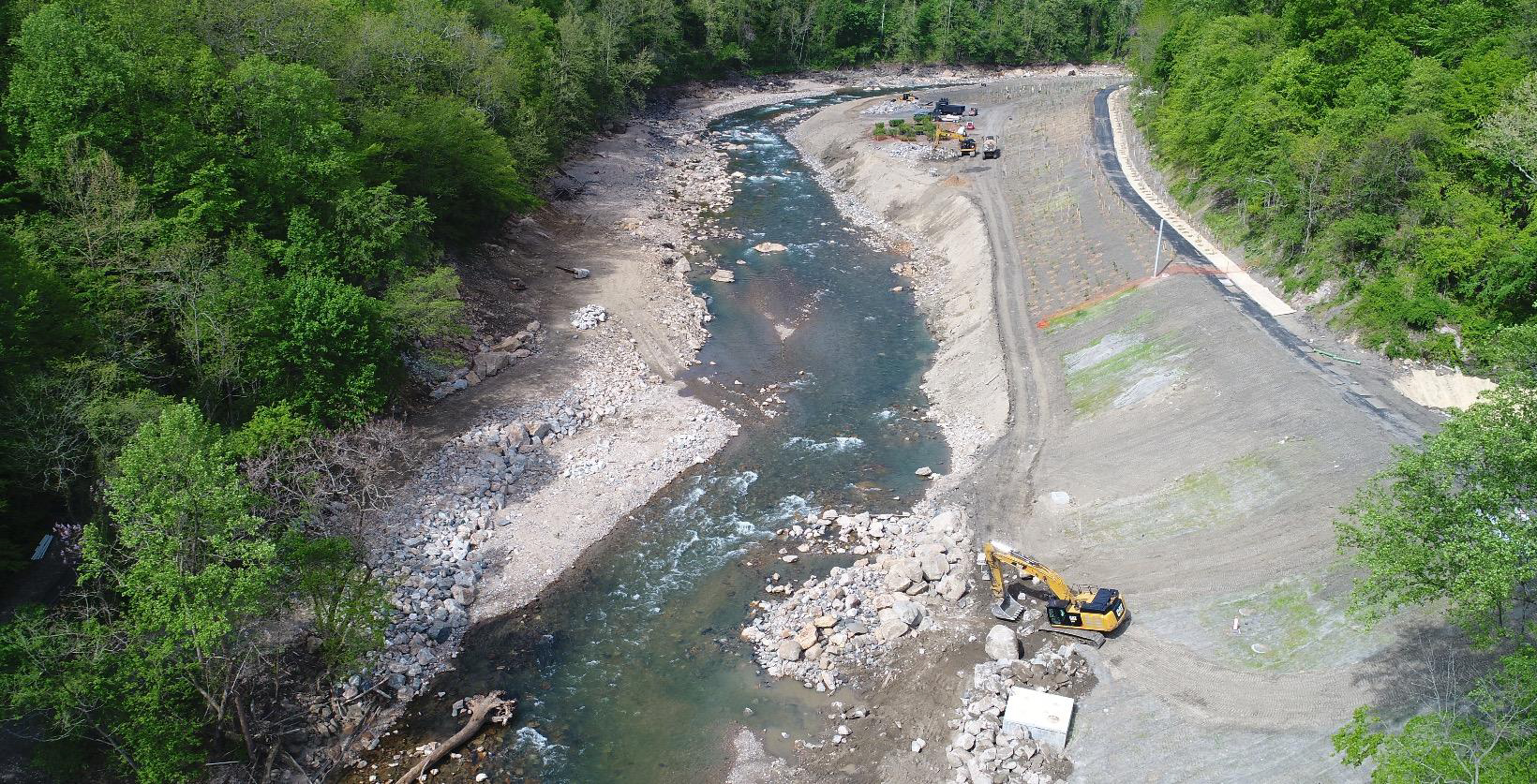
After years of planning by the Patapsco River Restoration Partnership, Bloede Dam the first blockage on the Patapsco River has been removed! Approximately 60 miles of habitat, including the mainstem and tributaries, are now open to migratory and resident fish. The complex project involved relocating a 42-inch diameter Baltimore County sewer line and a 12-inch diameter Howard County sewer line; the demolition of the fish ladder and dam structure; and the repaving of a section of the Grist Mill Trail.
The construction work has been completed and the work site planted with trees/shrubs to stabilize the bank. Two overlooks have been constructed, one on each side of the river. Informational signage about the history and removal of the dam is being prepared and will be installed at each overlook. The Grist Mill Trail has been reopened. Enjoy the new scenic view of a free-flowing Patapsco River!
Physical and biological monitoring of the site will continue for several years. However, we have already seen migratory fish as far upstream as Daniels Dam, north of Interstate 70!
View a story map of the Bloede Dam Project
This
story map created by our partner, American Rivers, guides you through the history of the Bloede Dam, its relationship with the Patapsco River and its ultimate removal.
Bloede Dam Project
Problem: The Bloede Dam is located within the Patapsco River State Park and was built in 1907. The dam is a public safety concern (deaths have occurred), an obstacle for fish passage, and it fragments river continuity and aquatic habitats.
Responsibility: Bloede dam is owned by the Maryland Department of Natural Resources.
Process: A feasibility study was commissioned to evaluate the dam's negative impact on the ecology of the Patapsco River and issues of public safety. After a thorough analysis and public input (2011-2012), the Department and project partners made the decision to move forward with the Bloede Dam removal with passive sediment management.
Timeline:
- Review bids - May 2016
- Select contractor - September 2016
- Mobilize equipment - August 2017
- Close Grist Mill Trail - September 2017
- Clear wooded area - October 2017
- Begin sewer line relocation - October 2017
- Remove old sewer line - Summer 2018
- Breach Bloede Dam - September 11, 2018
- Remove Bloede Dam - Winter 2018
- Plant trees, reconstruct Grist Mill Trail - Spring 2019
- Construct overlooks, demobilize - Summer 2019
Goals of the Bloede project:
-
Restore Fish and Aquatic Organism Passage
The Patapsco River once supported large runs of shad, herring, and American eels, but the construction of dams has blocked these historic migrations. The fish ladders constructed in the 1990's have proven to be ineffective at passing fish – especially American eel. -
Improvement of Public Safety
The Bloede dam is a significant public safety hazard, several deaths have occurred at or near the dam. -
Consider Historic, Cultural and Recreational Values
The Bloede Dam was built in the early 1900’s and is part of the Patapsco’s rich history. It is also a major feature of the Patapsco Valley State Park. Similarly, herring, and shad were once abundant and a staple of settlers in the Patapsco Valley. The cultural significance of each of these will be commemorated as part of this project and recreational boating and fishing values promoted.
Our Vision
With the removal of Bloede Dam, the department envisions a restored Patapsco River System with a wide range of benefits and long-term cost savings. It is recognized that this decision is not without potential adverse impacts.
A significant historical structure in Patapsco Valley State Park will be lost, there will be short-term impacts to the ecology of the river, fishing and other recreational opportunities will be affected, and there will be temporary inconvenience to park visitors.
However, there will be long-term ecological benefits to the Patapsco River and the Chesapeake Bay, including:
- Passage of anadromous fish and eels, thus achieving fish passage objectives
- Improved recreational opportunities (fishing, canoeing, kayaking, tubing) and enhanced public safety (removal of drowning hazard and elimination of dam-related injuries)
- Healthier populations of native fish species
- Increased diversity of aquatic insects
- Cooler, oxygen-rich waters that improve the fishery
- Long-term cost savings related to ongoing maintenance and repair of the dam structure and an ineffective fish ladder
- A more scenic and natural setting; the present dam aesthetics that some find attractive will be replaced over time with a rocky, more natural cascading river environment and setting
For more information contact Jim Thompson
[email protected].
Partners with:

